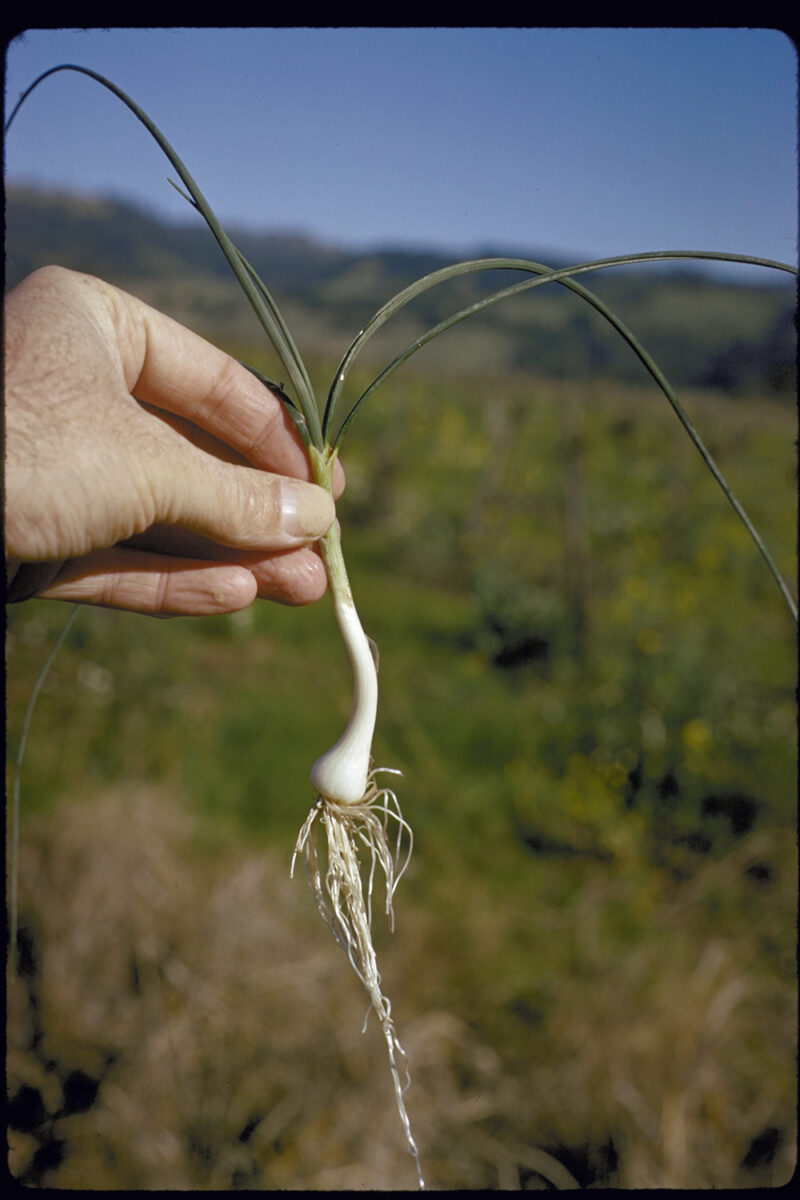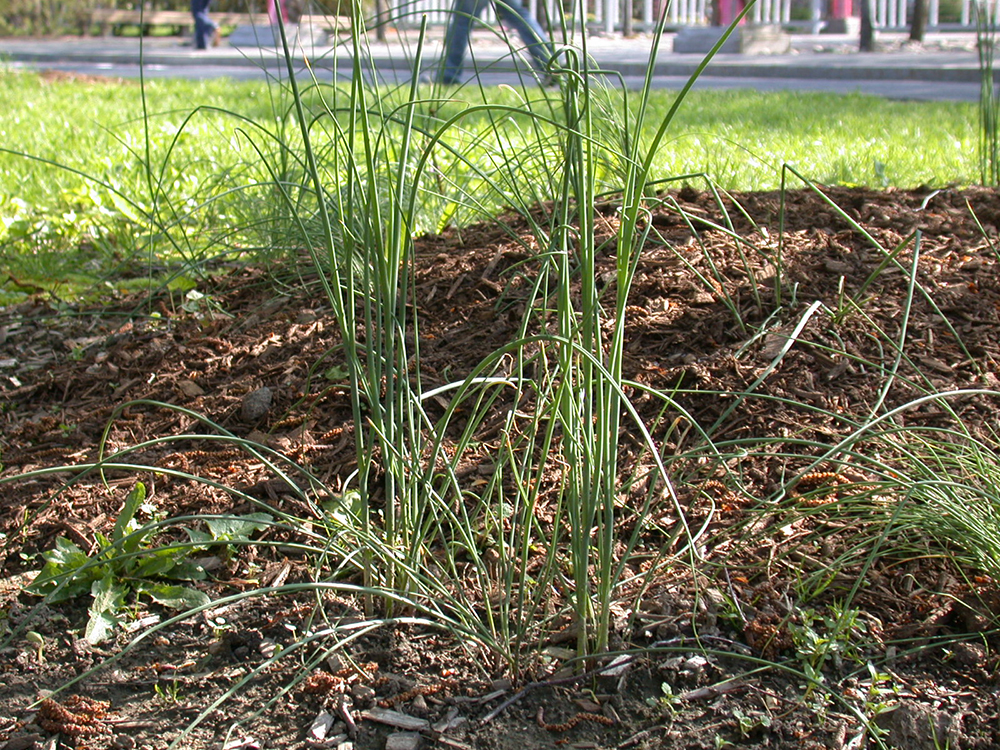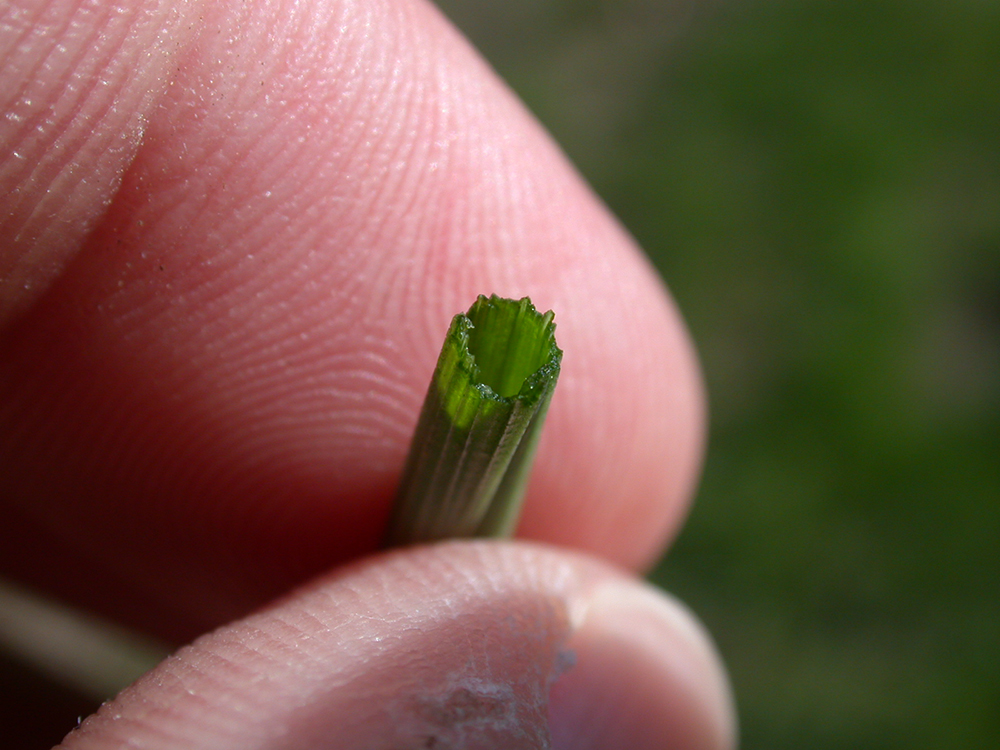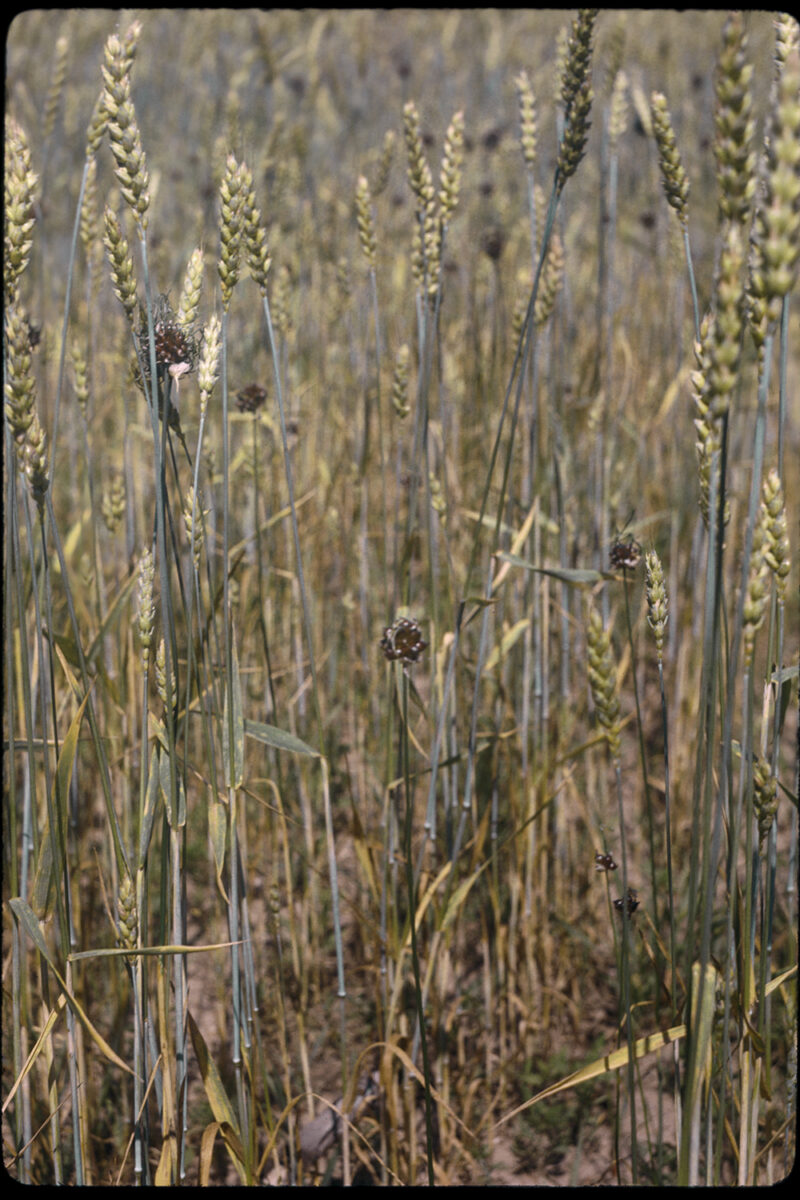Other common names: field garlic, wild onion, crow garlic, scallions, ramp




Allium vineale L.
Identification of Wild Garlic
Family: Lily family, Liliaceae
Habit: Perennial grass-like herb arising from a bulb
Description: Seedling leaves are slender, hollow, upright, hairless, round and grass-like in appearance. Seedlings smell of garlic or onion when crushed. Mature plant leaves are similar to seedling leaves. Leaves are 6–24 inches tall by 0.1–0.4 inch wide. Belowground bulbs are egg shaped, have papery coverings and can also develop in segments from the main bulb. A fibrous root system emerges from bulb bases. Stalks are unbranched, round, smooth, waxy, leafless and solid cored; the top of the stem gives rise to either aerial bulblets or flowers that emerge from a sheathed globular structure. Aerial bulblets are small and teardrop shaped, with a thin, green leaf emerging from the top. Maroon, pink or white-green flowers may develop on the globe above the bulblets on 0.25–1 inch-long stalks. Occasionally, flowers produce three-chambered, egg-shaped capsules that contain up to six flat, wrinkled, black 0.1 inch-long seeds.
Summary of reproductive structures and terminology used: Wild garlic reproduces primarily by production of four types of bulbs. Plants not sufficiently mature to produce a reproductive stalk form a terminal bulb in early summer that resumes growth in the fall. Plants producing reproductive stalks usually form a single large soft offset bulb below ground in the axil of an inner leaf. These generally sprout in the fall replacing the former terminal bulb. Larger plants forming reproductive stalks typically produce one to four hard offset bulbs in the axils of outer leaves that can remain dormant for two or more seasons and produce new plants. Aerial bulblets are small bulbs formed at the top of reproductive stalks. Most plants emerge from bulbs and bulblets; seed production is rare in much of the United States. When flowers occur, they form in the same heads as bulblets and can produce seeds.
Similar species: Domestic garlic (Allium sativum L.) plants generally have considerably larger stalks, bulbs and flowers than wild garlic. The flowering stalk of domestic garlic typically curves in a loop, whereas that of wild garlic is straight. Wild onion (Allium canadense L.) leaves are flat and solid when cut. Wild onion bulbs do not become hard when dormant. The white, star-shaped flowers and prominent, white midvein of star of Bethlehem (Ornithogalum umbellatum L.) distinguish it from wild garlic. Star of Bethlehem also lacks the strong characteristic odor of wild garlic.
Management of Wild Garlic
Wild garlic is not a competitive weed and rarely causes noticeable yield loss, but has a large impact by tainting farm produce, thereby reducing its value. When consumed by pastured livestock, it can produce a disagreeable taste in milk and meat. In addition, the bulblets are harvested with cereal grains and are difficult to clean out of the grain. Flour ground from contaminated grain has an unpleasant taste and odor. Moreover, even a low percentage of bulblets in the grain (0.01%) can cause caking on the mill, which necessitates frequent cleaning. Consequently, mills reject contaminated grain shipments or levy heavy docking fees. Wild garlic is less of a problem in vegetable crops, but separating the long thin leaves from salad and braising greens can substantially slow harvest and processing of these crops.
Wild garlic is best managed by late fall to early spring tillage. The optimal time for tillage is when two foliage leaves are well formed (do not count the short sprout leaf, which quickly withers). Tillage at this time destroys growing plants after food has been transferred to leaves but before new offsets and bulblets have formed. Since development is not synchronized across all plants, several years of appropriately timed tillage will be needed to bring an infestation under control. Repeated harrowing in fall and spring without primary tillage also greatly reduces the population but generally is no better than fall plowing followed by spring harrowing and a spring planted crop. Tillage in late spring will allow formation of offsets, but they will not have had time to form a hardened covering scale and, therefore, will not be dormant. Mowing or tillage when the stalks have started to lengthen but are not full height will prevent or reduce production of bulblets. Plants will, however, still produce dormant offset bulbs at the base of the plant. Summer fallow is useless for controlling wild garlic. Plowing in the fall before plants have two long foliage leaves will kill a few plants by deep burial, but many will resprout and develop normally.
Rotation of badly infested land to spring planted row crops is beneficial as it allows spring tillage and repeated cultivation to damage plants during the formation of offset bulbs and bulblet bearing stalks. If the land is rotated to a summer planted crop, precede the crop with a spring fallow or with early plowing followed by a rapidly growing cover crop. Spring sown cereal grains can also decrease wild garlic populations if tillage can be timed appropriately.
Like its domesticated relatives, wild garlic is a poor competitor that will be suppressed by several years of competition from a dense stand of perennial grasses or legumes. Hence, in lightly infested pastures, use good management practices to ensure a vigorous growth of grasses and legumes between grazing episodes. This will also dilute the percentage of wild garlic in the forage and thereby reduce the risk of tainting milk and meat. To reduce the potential for tainting of animal products, avoid early grazing of infested fields since wild garlic will present fodder to the animals before grasses and legumes begin growing. Badly infested pastures should be tilled in late fall or early spring and, if possible, rotated to crops in which wild garlic is more easily controlled for a few years. If the land is easily eroded, plant to a perennial hay crop and fertilize it well after establishment to ensure lush, vigorous growth.
Avoid planting winter grains on infested land. If the infestation is sparse, an occasional winter grain crop may be grown successfully if the stand is good and the crop is vigorous. Consequently, use a high seeding rate, and fertilize the crop well. These measures should greatly reduce the number of bulblet bearing stalks and hence contamination in the harvested grain. If the stand turns out poor, consider harvesting the crop for hay: the garlic flavor does not persist in dried hay as it does in fresh forage or silage.
Ecology of Wild Garlic
Origin and distribution: Wild garlic is native to Europe and western Asia, where it is widespread. It occurs also in North Africa and has been introduced into North America, Australia, New Zealand and Chile. In North America, the species is present throughout most of the eastern and central states, Ontario and the moister parts of the far west, including British Columbia and Alaska.
Seed and bulblet weight: Bulblets weigh 3–70 mg and occasionally more, with the median around 17 mg. Larger bulblets have a higher rate of sprouting than smaller bulblets. Seeds weigh 0.5–1.5 mg with a mean of 1.07 mg.
Dormancy and germination: All types of bulbs are dormant when produced, but terminal bulbs, soft offsets and most bulblets lose dormancy and begin sprouting by the summer or fall of the year they are produced. Bulblets lose dormancy after several months at 72°F but not at 33°F or 40°F, a pattern that favors plant establishment in early fall and a growth advantage when temperatures warm in early spring. Sprouting of bulblets was higher at 68°F than at 86°F. The hard, waxy scale on hard offsets tightly surrounds the bulb and, despite completion of after-ripening, typically delays germination for a year or longer. Eventually, these coverings split or decay, and the hard offset sprouts. Sprouting of non-dormant hard offsets was best at 50°F. Seeds require two to three months of cold, moist conditions to germinate.
Seed and bulb longevity: Terminal bulbs and soft offset bulbs usually die if they do not sprout the autumn after production. In one study, seeds and bulblets buried in the soil did not survive for a full year. In other studies, however, 4–5% of bulblets survived more than one year, but not longer. Hard offset bulbs can remain dormant in the soil for five years or more, though all but a few sprout within the first two to four years after production.
Season of emergence: Bulbs sprout from August until the ground freezes. Some shoots do not reach the soil surface until spring, however, so shoots emerge in both fall and early spring. Emergence in spring can also occur from bulbs at greater depth in the soil. Seeds would be expected to germinate in spring based on their need for a period of cold conditions (see the “Dormancy” section), but this has never been observed in the field.
Emergence depth: The ability of a bulb to produce a shoot depends on both depth and the size of the bulb. Placement on the soil surface reduced establishment and growth of plants compared to placement 0.5–0.75 inches deep. Bulblets emerge best from the top 2 inches and generally cannot emerge from deeper than 4–6 inches. Offset bulbs emerge best from the top 4 inches with minor emergence from 8 inches. The largest bulbs can emerge from the bottom of the plow layer (8–10 inches) or deeper (16 inches). The likelihood of a shoot producing a reproductive stalk, and the number of belowground daughter bulbs that a plant produces, declines with the depth of the parent bulb, particularly when the parent bulb is below 4–6 inches. Soft offset bulbs buried below this depth in fall or early spring produced few stems or inflorescence the following spring. In long established grass swards, the largest bulbs and the most vigorous plants have their bases at about 2.75 inches. This is apparently the optimum depth for terminal bulbs and hard offsets, and plants that first establish near the soil surface eventually pull themselves down to this depth by root contraction.
Photosynthetic pathway: C3
Sensitivity to frost: Wild garlic is very resistant to even hard frosts. The leaves sometimes brown and die back to the soil surface but continue to lengthen again in early spring along with additional new leaves.
Drought tolerance: Wild garlic is highly resistant to drought. Plant growth slows during dry weather, but the bulbs will survive long drought periods, even when uprooted and lying on the soil surface following tillage.
Mycorrhiza: Mycorrhiza have been observed. Mycorrhizal association with wild garlic is more important when nutrients are limiting.
Response to fertility: Balanced fertilizer application appropriate for winter grain production moderately increases the likelihood of flowering, the number of foliage leaves per plant, the number of offset bulbs and the average weight of the offset bulbs. Plants arising from bulblets, however, had slower growth and produced fewer hard offsets when balanced fertilizer was applied, probably due to osmotic effects. The strength of garlic’s flavor was reduced by sulfur deficiency in the nutrient medium.
Soil physical requirements: Wild garlic grows successfully on a wide range of soil textures from heavy clay to coarse sand. Bulbs can survive an entire growing season in waterlogged soil.
Response to shade: Wild garlic tolerates moderate shade, but like its domestic relatives it is easily suppressed by competition from more robust plants. In particular, competition from a vigorous crop greatly decreases formation of reproductive stalks, though in most cases the population will maintain itself by production of belowground bulbs.
Sensitivity to disturbance: Wild garlic plants can be completely killed by burial at the two-leaf stage to early three-leaf stage (the little sprout leaf does not count in this regard). Shallow burial before this stage will result in resprouting and normal growth. Deep burial at greater than 4 inches, however, will kill most younger plants. Burial after the second- to early third-leaf stage may appear to have killed the plants, but they will form bulbs underground from energy stored in the leaves. Cutting the flowering stalk when it first forms prevents production of bulblets but increases the size of offset bulbs by as much as three-fold. Bulblets will continue to mature on a cut off or buried reproductive stalk once the stalk has reached its full length, even if the head has not begun to swell. Plants survive multiple defoliations by mowing or grazing. Plants cut in late spring or summer wait to resprout until the usual time in the fall. Dormant bulbs are essentially immune to management practices other than digging and removal.
Time from emergence to reproduction: Shoots emerge throughout the fall, and reproductive stalks typically appear in mid-spring. Plants require a cold treatment to induce stalk formation. Stalks produce mature bulblets by late spring or early summer. Plants establishing from bulblets generally require two to four seasons to mature.
Pollination: The occasional flowers that are produced are cross pollinated by bumblebees and flies.
Reproduction: Wild garlic reproduces primarily by production of the various bulb structures described above, but occasional plants produce flowers and seeds as well. Most reproduction occurs by formation of bulblets on the reproductive stalk, where flowers would be expected on domesticated garlic. Four populations in Sweden produced 75–141 bulblets per plant. Production of seeds varies greatly with season, locality and among plants, ranging from three to 70 seeds per inflorescence. Seed production is rare in the northeastern United States. Some genotypes of wild garlic tend to allocate more resources toward belowground asexual offsets and, occasionally, sexually produced seeds, whereas other genotypes allocate more to aerially produced bulblets and less to offsets or seeds.
Dispersal: Bulblets and seeds disperse similarly short distances, with the majority found within 14 inches of the inflorescence. Bulblets move in contaminated seed grain and especially in rye and winter wheat used as cover crop seed since this is rarely certified for seed quality. They are sometimes found in straw. They also travel in mud on tires, farm implements, shoes and the feet of livestock. Bulblets will float for many hours and likely disperse with overland flow off of fields, along waterways and by blowing across ponds and lakes.
Hard offsets disperse little distance from the parent plant but can remain dormant several years, allowing them to disperse in time. In contrast, bulblets do not survive more than a year but can disperse long distances by the mechanisms discussed above, although most fall within a meter of the parent plant. Bulblet performance is maximum when dispersed 10 inches and declines with increasing dispersal distance from the parent plant, suggesting that local adaptation occurs at the scale of natural dispersal, thereby favoring asexual reproduction. The evolutionary contribution of seeds to survival of the species has yet to be clarified.
Common natural enemies: Several fungi cause extensive damage to belowground bulbs. These include onion white rot (Sclerotium cepivorum) and various species of Penecillium and Fusarium. Slugs and rabbits feed on the foliage.
Palatability: The bulbs are occasionally used to flavor cooked dishes, but most people consider the flavor much inferior to that of domestic garlic. The bulbs do, however, contain substantial concentrations of the same beneficial antioxidants found in domestic garlic. Livestock readily eat wild garlic leaves and shoots, but consumption of fresh material can taint milk and meat. The flavor persists through the silage-making process but is not present in dried hay. Consumption of large quantities of wild garlic can cause poisoning in both people and livestock.
Summary Table of Wild Garlic Characteristics
| Wild Garlic | ||||||||
|---|---|---|---|---|---|---|---|---|
| Growth habit | Perennial overwinter organ | Emergence period from perennial organs | Optimum emergence depth (inches) from perennial organs | Time/stage of lowest reserves | Photosynthesis Type | Frost tolerance | Drought tolerance | Mycorrhiza |
| short allium | bulbs | fall and early spring | 1–4 | 2 leaves | C3 | high | high | yes |
| Fertility Response | Importance of seeds to weediness | Seed weight (mg) | Dormancy of shed seeds | Factors breaking dormancy | Optimum temperarature range (F) for seed germination | Seedling emergence period | Emergence to flowering (weeks) | |
| low | low | 0.5–1.5 | yes | cms | – | – | mid-spring | |
Table Key
Perennial overwinter organ: Principal plant organ that survives winter and from which growth resumes in subsequent years.
Emergence period from perennial organs: Time of year when most emergence occurs from perennial overwintering organs in the typical regions of occurrence for each weed. Some emergence may occur outside of this range.
Optimum emergence depth from perennial organs: Soil depths (in inches below the soil surface) from which most shoots emerge from perennial organs. Lower rates of emergence usually will occur at depths above or below this range.
Time/stage of lowest reserves: Time of year and/or weed growth stage at which carbohydrate reserves are lowest. This usually corresponds to the time when the weed is most susceptible to weed management operations.
Frost tolerance: Relative tolerance of aboveground shoots to freezing temperatures (high, moderate, low).
Drought tolerance: Relative tolerance of aboveground plants to drought (high, moderate, low).
Importance of seeds to weediness: The relative importance of seeds to dispersal, genetic diversity and survival of the species as a weed in agricultural environments (high, moderate, low). Emergence to flowering: Length of time (weeks) after emergence from perennial organs to the beginning of flowering in the typical regions of occurrence. Note that this refers to established perennial plants, recognizing that some species may not flower in their initial year of establishment.
Further Reading
DeFelice, M.S. 2003. Wild garlic, Allium vineale L. – little to crow about. Weed Technology 17: 890–895.
Håkansson, S. 1963. Allium vineale L. as a weed, with special reference to the conditions in south-eastern Sweden. Växtodling (Plant Husbandry) 19: 1–208.
Lazenby, A. 1961. Studies on Allium vineale L.: I. The effects of soils, fertilizers and competition on establishment and growth of plants from aerial bulbils. Journal of Ecology 49: 519–541.
Lazenby, A. 1962b. Studies on Allium vineale L. IV. Effect of cultivations. Journal of Ecology 50: 411–428.
Peters, E. J. and S. A. Lowance. 1981. Effects of date and depth of burial on wild garlic (Allium vineale) plants. Weed Science 29: 110–113.

